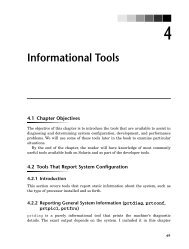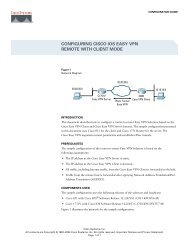OpenVPN Access Server System Administrator Guide
OpenVPN Access Server System Administrator Guide
OpenVPN Access Server System Administrator Guide
You also want an ePaper? Increase the reach of your titles
YUMPU automatically turns print PDFs into web optimized ePapers that Google loves.
2.2.1 One Network Interface on Private Network Behind the Firewall<br />
This configuration is most commonly seen when the <strong>Access</strong> <strong>Server</strong> resides in an internal corporate<br />
network, providing VPN access to users outside the corporate network. In this configuration the<br />
<strong>Access</strong> <strong>Server</strong> has one network interface connected to the private network (note that other<br />
interfaces may be present on the system but will not be utilized in by the <strong>Access</strong> <strong>Server</strong>). This<br />
scenario is illustrated in Figure 2.<br />
PRIVATE IP<br />
NETWORK<br />
PRIVATE IP<br />
Internet Gateway / Firewall<br />
PUBLIC IP<br />
PUBLIC IP NETWORK<br />
(INTERNET)<br />
<strong>OpenVPN</strong> <strong>Access</strong> <strong>Server</strong> <strong>System</strong> <strong>Administrator</strong> <strong>Guide</strong><br />
PRIVATE IP<br />
<strong>OpenVPN</strong><br />
ACCESS<br />
SERVER<br />
Figure 2: <strong>Access</strong> <strong>Server</strong> on Private Network Behind a Firewall<br />
In this configuration, it is required that the Internet Gateway be set up to forward desired TCP/UDP<br />
port traffic from the public IP to the <strong>Access</strong> <strong>Server</strong>‟s private IP address. At a minimum, one TCP<br />
port (typically port 443) needs to be forwarded,. That can carry both the VPN tunnel traffic and the<br />
Web Client <strong>Server</strong>/Connect Client traffic. Optionally, the VPN tunneling can be separated from the<br />
Web Client <strong>Server</strong> traffic, in which case an additional TCP or UDP port (e.g., UDP port 1193)<br />
must be forwarded for the VPN tunnel purposes.<br />
A variation on this network configuration has the <strong>Access</strong> <strong>Server</strong> with one interface attached to a<br />
DMZ network provided by the firewall. The same forwarding of client traffic is required (as<br />
above); additionally, the firewall may need to be configured to allow traffic between the <strong>Access</strong><br />
<strong>Server</strong> and the private network behind the firewall.<br />
2.2.2 Two Network Interfaces, One on Public and One on Private Network<br />
This configuration is most commonly seen when the <strong>Access</strong> <strong>Server</strong> resides in an internal corporate<br />
network but it also has its own public IP address (see Figure 3). The <strong>Access</strong> <strong>Server</strong> communicates<br />
with clients outside the corporate network via its public IP interface. It uses another network<br />
interface to communicate with hosts on the private IP network and to propagate packets between<br />
VPN tunnels and the private network.<br />
6
















